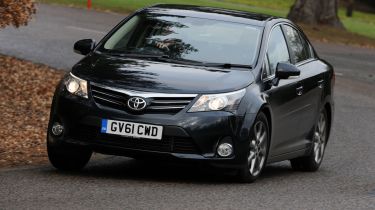Toyota Avensis 2.0 D-4D
Tweaks to chassis, engine and looks aim to transform saloon
The Toyota Avensis is the forgotten car of the large family car market. It’s dependable but dull, and has failed to make much of an impact on the class leaders.
Toyota hopes to change that, and take the Avensis to the top, with a sharper chassis and efficient new engines. The styling has been tweaked, too, although you’ll need to be alert to spot the visual changes.
At the front it features subtly restyled headlamps, a wider grille and reprofiled bumper, while at the rear are new LED tail-lights. Otherwise, the low-key Avensis looks exactly the same as before.
The car in our pictures is a T4 model, but apart from the smoked chrome alloys it’s visually identical to our TR test car. Either way, the Avensis is a well proportioned and inoffensive design; it just lacks the head-turning appeal of the Kia.
The theme continues inside, where you’ll discover a logically laid-out but blandly styled cabin. Yet look past the uninspiring design, and you’ll discover top-notch quality that even the Kia can’t match.
The soft-touch plastics, slick switchgear plus flawless fit and finish are clearly influenced by Toyota’s luxury Lexus brand. Buyers also benefit from a decent haul of desirable kit, including a reversing camera, dual-zone climate control and sat-nav.
Used - available now

2022 Peugeot
E-2008
17,336 milesAutomaticElectric
Cash £13,400
2021 Peugeot
2008
9,432 milesManualPetrol1.2L
Cash £15,100
2023 Jaguar
I-PACE
23,066 milesAutomaticElectric
Cash £21,697
2024 Kia
Stonic
18,073 milesAutomaticPetrol1.0L
Cash £15,002There’s also no shortage of space, with the wide rear bench accommodating three adults thanks to the neat flat-floor layout. What’s more, there’s plenty of storage due to a deep, lidded cubby between the front seats, a large glovebox and roomy door bins, and the well shaped boot swallows 509 litres of luggage. Unlike the Optima, buyers also have the option of a practical Tourer estate.
While the Toyota narrowly wins the space race, it trails on pace. The refined 2.0-litre diesel has 10bhp less power than the Optima’s engine, at 124bhp, and the tall gear ratios – chosen with efficiency in mind, rather than performance – blunt acceleration.
In the real world the Toyota simply doesn’t feel as eager as its rival, requiring more space to overtake slower traffic. Yet while it’s not as fast, it’s slightly more refined, with similarly low wind noise, less tyre roar than the Optima and a smooth ride. The Avensis is a relaxing and comfortable long-distance cruiser.
Revisions to the steering, dampers and rear suspension have also improved the driving dynamics. There’s still very little feedback and it’s not as poised as the Kia, but the Toyota is composed and inspires confidence in corners.
But it will be the running costs that catch the eye of most buyers. The £21,525 Avensis undercuts its rival by £170 and is a cheaper company car choice due to its low 119g/km CO2 emissions. Our only cause for concern was our 30.5mpg fuel economy; even though this was over a short test route and included our performance testing, it’s a disappointing figure. Will this cost the Toyota dear?
Details
Chart position: 2
WHY: The capable but dull Avensis has never had the star quality to shine in this class. A facelift aims to take it to the top.







